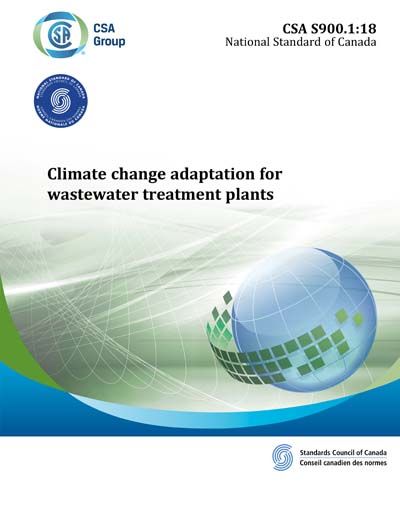Most recent
CSA S900.1-2018
Climate change adaptation for wastewater treatment plants
Preface This is the first edition of CSA S900.1, Climate change adaptation for wastewater treatment plants. This Standard is intended to provide owners of wastewater treatment plants with a comprehensive resource for design, operation, and retrofit criteria that can be implemented to increase the resilience of such plants. The Wastewater Treatment Plant Component and Climate Change Checklist Database aids users in deriving relationships between components of WWTP projects and the potential impacts of extreme weather events as they relate to climate change. The database identifies potential impacts based on plant components and weather impacts (ASHRAE Handbook?Fundamentals, Chapter 14). The database can be downloaded from the following link: https://csagroup.org/documents/CSA_S900.1-18EN_ Database_FINAL.xlsm. This project was made possible through the generous support of the National Research Council of Canada as part of its Climate-Resilient Buildings and Core Public Infrastructure (CRBCPI) Project. This Standard has been developed in compliance with Standards Council of Canada requirements for National Standards of Canada. It has been published as a National Standard of Canada by CSA Group. Scope 1.1 This Standard addresses considerations for adapting wastewater treatment plants (WWTPs) to a changing climate by reviewing climate, regulatory, risk, design, construction, and operations and maintenance aspects. It applies to existing, new, or retrofit/upgrade projects. 1.2 This Standard provides a user-friendly framework and tool for designers, engineers, and managers to use when designing, constructing, or operating/maintaining WWTPs. Note: The intention is to provide guidance for applying the tool to other infrastructure projects to assess risks related to climate change and to rank and prioritize actions to build in resilience and/or redundancy and to develop contingency plans, without indiscriminate overdesign. 1.3 This Standard provides guidance on climate change data sources and how to use them in determining impacts on WWTP components. 1.4 This Standard highlights climate change adaptation measures for building resilience and addressing high-risk scenarios related to WWTPs. 1.5 This Standard applies to the WWTP itself and its processes and property. It does not apply to collection systems feeding into the plant or to disposal receivers. 1.6 In this Standard, "shall" is used to express a requirement, i.e., a provision that the user is obliged to satisfy in order to comply with the standard; "should" is used to express a recommendation or that which is advised but not required; and "may" is used to express an option or that which is permissible within the limits of the standard. Notes accompanying clauses do not include requirements or alternative requirements; the purpose of a note accompanying a clause is to separate from the text explanatory or informative material. Notes to tables and figures are considered part of the table or figure and may be written as requirements. Annexes are designated normative (mandatory) or informative (nonmandatory) to define their application.
CSA America, Inc. [csa]

